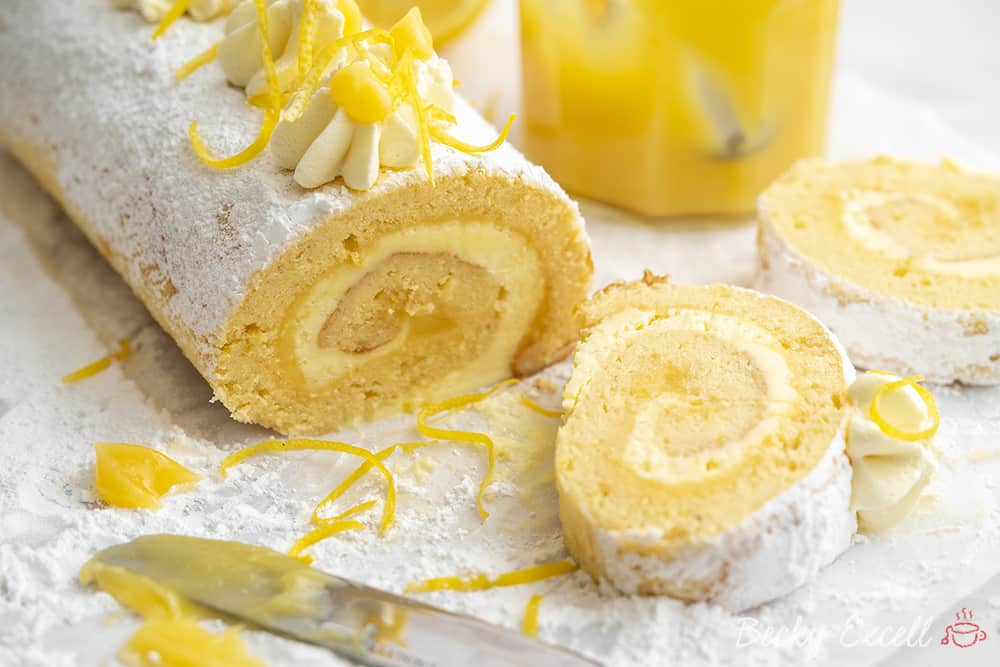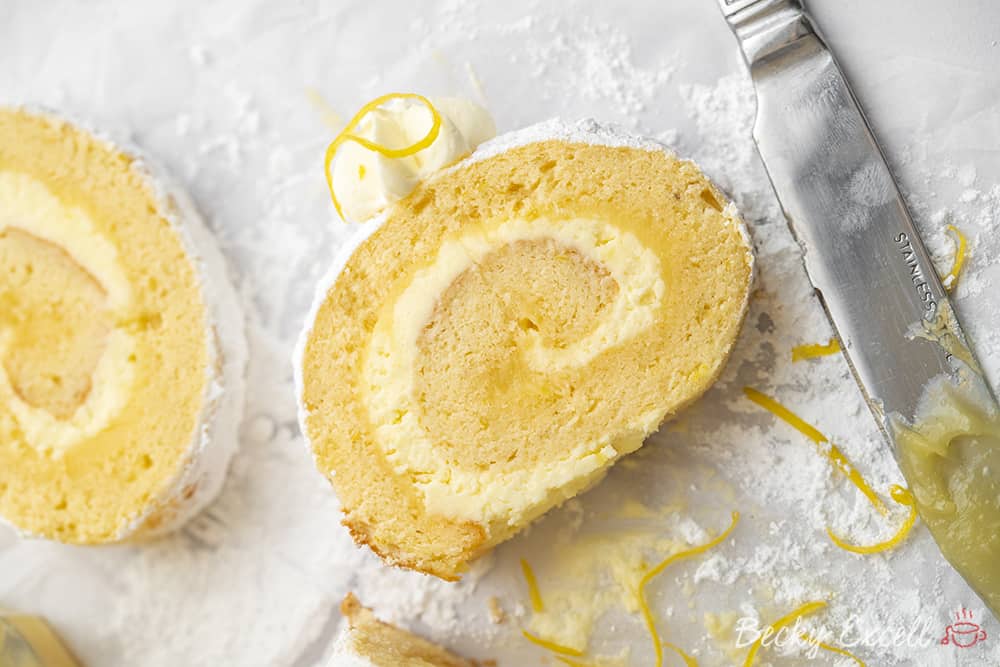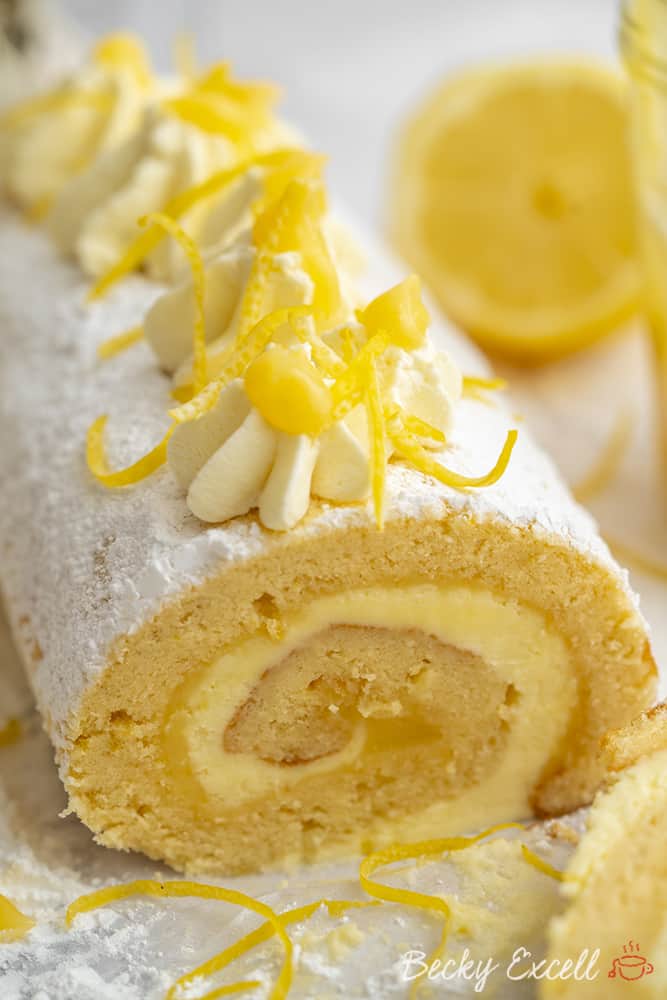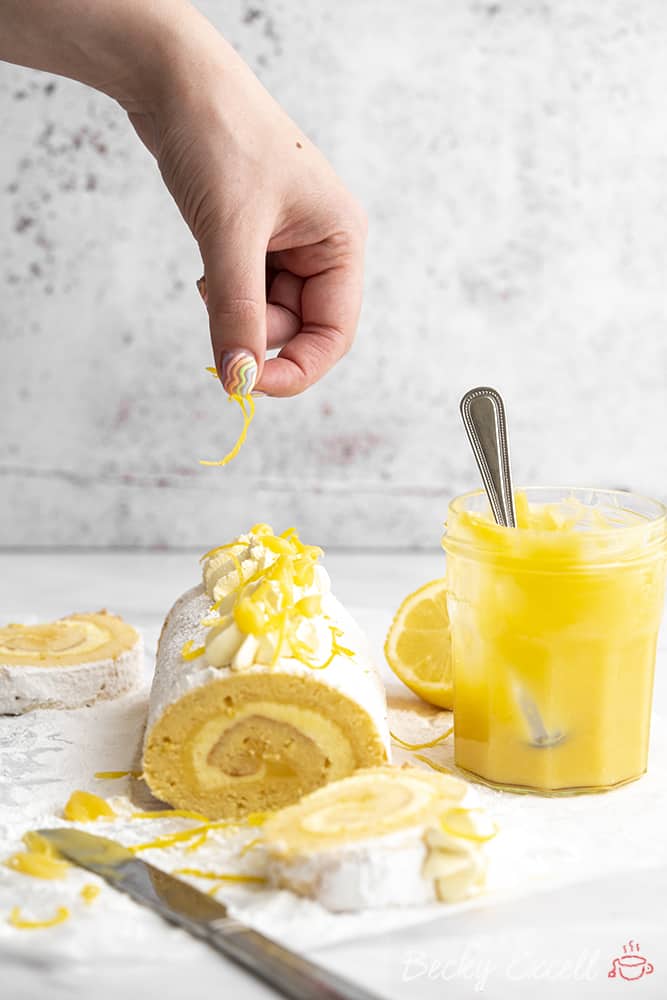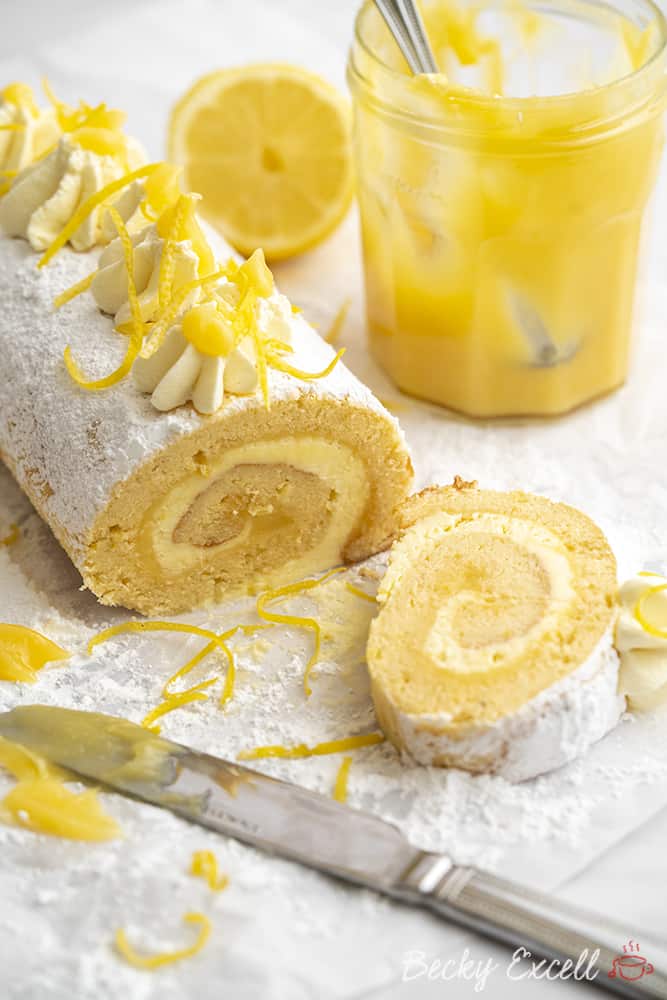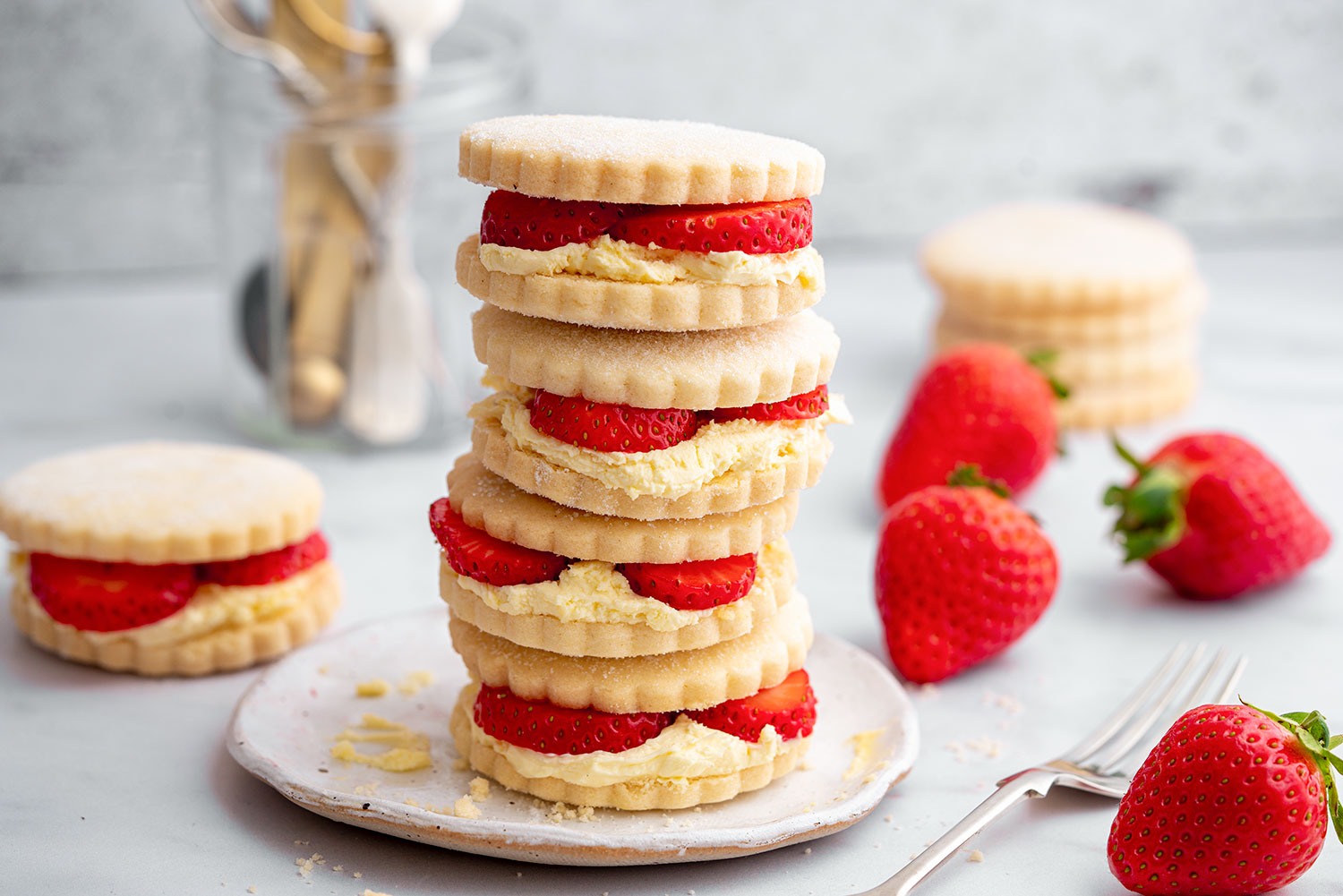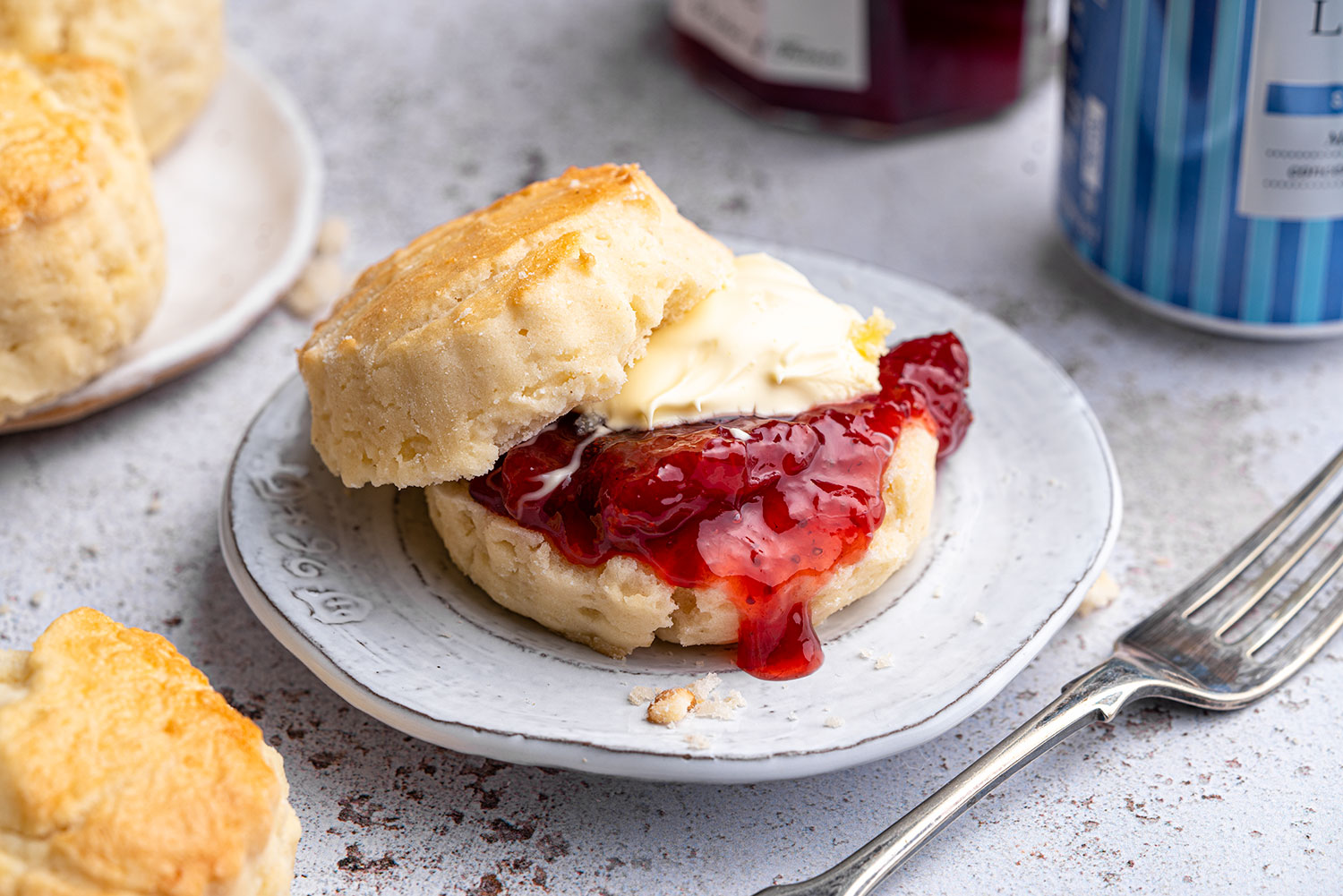Gluten-free lemon swiss roll recipe – who needs gluten when baking is this easy? And yup, nobody would know it’s Coeliac-friendly and wheat-free too.
Gluten-free lemon swiss roll recipe, anyone? Yep, a light, fluffy sponge filled with whipped cream and lemon curd, topped with icing sugar. Who could resist? See the FAQ section for advice on adapting this recipe to be dairy-free.
When I joked about gluten-free brownies being the only gluten-free option in coffee shops (or restaurants when it came to dessert) about 6-7 years ago, I never thought that would still be the case today.
Worst of all, I’m not even sure if the quality of said gluten-free brownie has even remotely improved in half a decade either!
But that seemingly never-ending scenario just makes it all the more mind-blowing when you bake something *genuinely exciting* at home – especially when it doesn’t taste or look gluten-free. Like this!
Here’s a few reasons you need to give this a try if you weren’t convinced already…
Why make my gluten-free lemon swiss roll recipe?
- The sponge is incredibly light and zesty, filled with a simple and quick whipped cream with lemon curd.
- You’ll learn the secret to making a gluten-free swiss roll that doesn’t crumble into a million crumbs when you try to roll it. Make this and you can make all of my other swiss roll recipes, no problem.
- Best of all, you’d never know it was gluten-free by tasting it or looking at it – it’s super soft, moist and NOT crumbly or dry at all.
- You wouldn’t believe how quickly you can throw this together, simple bake the sponge, roll up and allow to cool. Then spread lemon curd, whipped cream and roll.
But what does my gluten-free lemon swiss roll taste like, I hear you ask? Good question!
The lemon sponge cake itself is incredibly light thanks to the process of whipping the egg whites separately and folding them in. Of course, the flavour is simply the ‘zest’!
And as if that wasn’t fluffy and cloud-like enough, in comes the whipped cream, cut with sweet, zesty lemon curd.
Finishing it is totally up to you – I finished mine with icing sugar, piped a little extra whipped cream on top and added a sprinkling of lemon zest.
Here’s everything you’ll need for my gluten-free lemon swiss roll recipe – consider this your shopping list! Keep scrolling until you see the recipe card below if you’re looking for the full ingredients and method.
Gluten-free lemon swiss roll recipe: What you’ll need…
- Medium eggs: I used medium eggs, so to ensure yours turns out the same, I’d recommend you do too! Unfortunately, you cannot make this recipe egg-free due to the amount of eggs required and the fact that they’ll need to be separated.
- Caster sugar: In a swiss roll sponge, sugar is incredibly important, so don’t reduce the amount, or even worse, remove it entirely – it won’t work!
- Vegetable oil: Vegetable oil keeps the sponge super moist and is incredibly important considering there’s actually no butter in the sponge.
- Lemon zest and juice: Yep, all the flavour we’ll need comes from actual lemons – no extracts required.
- Milk: The protein in milk helps give a gluten-free sponge structure, so don’t skip this even though it might seem like you can!
- Gluten-free plain flour: I use Doves Farm’s FREEE gluten-free plain flour blend that you can find in the supermarket. Can’t find it in your part of the world? You can always use my homemade gluten-free plain flour blend.
- Xanthan Gum: This is a binder and incredibly integral to ensuring that a gluten-free sponge can be rolled up without cracking or breaking. Don’t even think about leaving this out!
- Double cream: The filling for this beauty is essentially a lovely, lemon-y, zesty whipped cream, so double cream is what’s needed for the job here.
- Icing sugar: Of course, you can’t use caster sugar for the icing – that’s what icing sugar is for!
- Lemon curd: It’s up to you – use store-bought lemon curd or make your own using my 4-ingredient lemon curd recipe here. The choice is yours.
So I thought I’d kick things off with a little frequently asked questions section – if you just want the recipe, then keep scrolling.
But I’ve thrown in some tips here that will be really helpful if this is your first time making this, or you want to adapt it. So here they are!
Gluten-free lemon swiss roll recipe: Frequently Asked Questions
Can I make this recipe gluten-free? Is it suitable for Coeliacs?
It is gluten-free, though nobody would know just by tasting it – trust me!
Bear in mind that minimising cross-contamination is hugely important if you’re Coeliac or making this for someone who is. Here’s some tips from Coeliac UK on minimising the risk of cross contamination:
Also, make sure that all ingredients used don’t have any gluten-containing ingredients. Then make sure that they also don’t have a ‘may contain’ warning for gluten, wheat, rye, barley, oats (which aren’t gf), spelt and khorasan wheat (aka Kamut).
Here’s some more info from Coeliac UK on identifying safe gluten-free products.
Can I make your gluten-free lemon swiss roll recipe dairy free?
Of course, mini eggs aren’t dairy-free, but you can actually make the entire swiss roll dairy-free with three simple swaps:
- Use dairy-free milk
- Use dairy-free double cream: Elmlea Plant Double Cream (has a ‘may contain’ warning for milk and easily found in supermarkets) or if you have a milk allergy, Flora Plant Professional Double Cream (no may contain warning for milk, but can only be bought online). Of course, if you’re having trouble sourcing either, you can always just make a simple lemon buttercream and use that instead.
- Ensure your lemon curd is dairy-free or make your own dairy-free version using my 4-ingredient lemon curd recipe here.
Can I make your gluten-free lemon swiss roll recipe vegan?
Unfortunately, because this recipe involves separating eggs, egg replacements aren’t possible here and it cannot be made vegan.
Can I make this recipe low FODMAP?
Unfortunately, as double cream is high in lactose in this quantity and because dairy-free alternatives often contain high FODMAP ingredients, this recipe is not low FODMAP.
However, if you use lactose-free milk and make a lemon buttercream (use instead of making the whipped cream), then this recipe will suddenly become low FODMAP!
Can I make your gluten-free lemon swiss roll in a food processor or standing mixer?
Of course you can – and it’ll save you on elbow grease! I don’t use a standing mixer or food processor to make the cake mixture personally – I use an electric hand whisk like this.
As this recipe doesn’t require longer periods of mixing, I find that an electric hand whisk is the quickest and easiest option.
However, don’t even think about using an electric mixer to fold the fluffy egg whites into the main mixture – this must be done by hand!
Can I make your gluten-free lemon swiss roll recipe by hand?
You can of course, bake this without any assistance from any appliance and simply use a hand whisk. However, you must ensure that you whisk the egg whites for long enough to achieve medium peaks, otherwise the recipe won’t work!
Ensure everything is well combined with no pockets of flour or dry ingredients as you go.
Do I need any special equipment to bake your gluten-free lemon swiss roll recipe?
Certainly not! What you will need however is a swiss roll tin – I use this one by Mary Berry and Lakeland, it’s 35cm by 25cm.
If you’re in a bit of a pinch and don’t have a swiss roll tin, you can easily use a baking tray instead as long as it’s roughly the same size and sides aren’t too low.
Oh and make sure you have some baking paper – I use Bacofoil. You’ll definitely need this to successfully roll up your sponge.
Does this recipe need xanthan gum?
You’ll see xanthan gum in a lot of my recipes as it’s an essential ingredient in gluten-free baking. And that’s exactly the case here.
How else would a gluten-free sponge be able to perform the miraculous feat of rolling up without breaking? Xanthan gum is the star here!
So yes, if you can tolerate xanthan gum, please ensure that you use it. Otherwise, I wouldn’t recommend attempting this recipe.
Can I make this recipe using other gluten-free flours like buckwheat flour or coconut flour?
There’s a big difference between ‘gluten-free plain/self-raising flour’ and a *singular* type gluten-free flour. When I say ‘gluten-free plain or self-raising flour’ in a recipe, I mean a BLEND of gluten-free flours, not just one, singular flour.
Most gluten-free flour you buy in the supermarket typically contains a blend of rice flour, potato flour, maize flour, tapioca flour AND buckwheat flour. That’s a lot of different flours!
In gluten-free self-raising flour, there’s usually even a little baking powder and xanthan gum in it too which always helps. So to replace it with just one specific type of flour… that’s not going to cut it at all. Definitely go for a gluten-free flour blend.
Do I need weighing scales to bake your gluten-free lemon swiss roll recipe?
In short… yes, yes and yes! And I wouldn’t advise attempting any of my recipes without them.
A lot of work went into fine tuning ratios and quantities and for me, baking is all about consistency and precision. I want you to make this recipe and for it to turn out EXACTLY like mine did.
I’d recommending using digital cooking scales like these so you know you’re getting an accurate measurement and replicating my recipe as accurately as poss.
How long can I keep your gluten-free lemon swiss roll for?
I’ve kept my gluten-free lemon swiss roll for 3-5 days in an air-tight container in the fridge with no problems.
If you need to keep it any longer than that, I’d highly recommend freezing it (see advice below for doing that).
When the sponge starts getting a little dry, it’s probably starting to get past its best.
Can I freeze your gluten-free lemon swiss roll?
Of course! I’ve frozen it for up to 2-3 months no problem. Ideally, slice up the cake first before freezing. Then, you can easily defrost a few slices at a time instead of the entire thing.
When you want to eat it, each slice should take around 3 hours to defrost at room temperature.
How can I tell when my gluten-free lemon swiss roll is done?
Grab a skewer and give it a poke in the centre. If it comes out clean, then it’s done!
But if the skewer comes out moist and cake-like, it’s best to pop it back in for a bit longer.
Gluten-free lemon swiss roll Recipe: Method
Oh and here’s a printable version of my gluten-free lemon swiss roll recipe. Please remember to give it 5 stars if you tried it and enjoyed it as it helps people know it’s worth trying too! ⭐️ Feel free to leave your written reviews in the comments below this post.

Gluten-free Lemon Swiss Roll Recipe (dairy-free option)
Equipment
Ingredients
For the sponge:
- 4 medium eggs separated
- 100 g caster sugar
- 2 tbsp vegetable oil
- 2 tbsp milk or dairy-free if necessary
- zest of 1 lemon
- 1-2 tsp lemon juice
- 60 g gluten free plain flour
- 1 ⁄4 tsp xanthan gum
For the filling
- 250 ml double cream see FAQ section for dairy-free alternatives
- 1.5 tbsp icing sugar
- 125 g lemon curd homemade or shop bought - ensure dairy-free if necessary
- 1 lemon zested
Instructions
For the sponge:
- Preheat your oven to 180°C fan / 200°C. Lightly grease your Swiss roll tin and line with non-stick baking paper.
- Separate your eggs into two small bowls - egg whites in one and yolks in the other.
- In a large mixing bowl, add your egg yolks and half the caster sugar (50g). Whisk together until combined, then add your lemon juice, lemon zest, milk and oil and whisk once more. Sift in the flour and xanthan gum, and mix in until well combined, thick and glossy.
- In a separate bowl, whisk your egg whites (using an electric hand whisk or stand mixer ideally) until they start to turn white and frothy. Gradually add the remaining caster sugar (50g), whisking until you have medium peaks.
- In three stages, add your egg white mixture to your egg yolk mixture, folding it in carefully between each addition using a silicone spatula. Once all the egg white mixture is fully folded in, pour your mixture into your prepared tin. Spread it out gently to make sure it’s nice and even and bake in the oven for 10–12 minutes until cooked through.
- Place a piece of non-stick baking paper on your work surface and dust it with the icing sugar.
- While your sponge is still warm, loosen it from the tin and flip it out onto the baking paper. Peel off the baking paper on top that once lined the tin – don’t worry if you lose the outer layer of the cake because it sticks to the paper as you peel it off, that’s totally normal. Using your baking paper, roll the sponge up from the short end – the paper should be inside it as you roll. Try to roll fairly tightly, then leave the sponge to cool fully while rolled up. I prop something up against it to stop it from unrolling itself.
For the filling:
- Place your double cream and icing sugar into a bowl and whip together until it stiffens up - try not to over whip though.
To assemble:
- Carefully unroll your sponge and remove the baking paper. Fortunately I never find the sponge cracks using my recipe, but if it does a little, it doesn't matter - it will all be covered in icing - just be delicate!
- Spread a thin layer of lemon curd on the unrolled sponge (I leave about a half cm gap around the edge). Then spread a layer of whipped cream on top of that (not all of the cream!). Carefully roll the sponge back up and transfer it to a serving board or plate. Do this as tight as you can for the best swirl. If a little oozes out don't worry.
- Dust the swiss roll with plenty of icing sugar.
- Finish by spooning some of your whipped cream into a piping bag with a star nozzle. Then pipe dollops of the cream on top of the swiss roll - this is optional really! Drizzle with a little lemon curd and some lemon zest. Slice and enjoy!
Notes
Nutrition
Any questions about the recipe? Please do let me know by following me on Instagram and leaving me a comment on a recent photo!
Thanks for reading,
Becky xxx
Don’t forget to pin this for later!

